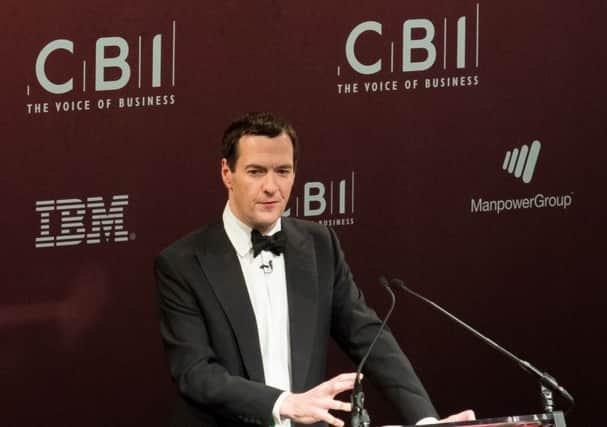Boost for public coffers as emergency Budget nears


Net borrowing – stripping out the impact of banking bailouts – topped £6.8 billion in April, down 27 per cent on the same month last year, according to the Office for National Statistics (ONS) yesterday. The shorfall had been forecast to come in at a little over £8bn.
The public finances were bolstered by bumper VAT receipts as well as spending cuts.
Advertisement
Hide AdAdvertisement
Hide AdIt marks the first set of monthly borrowing figures for the 2015-16 fiscal year as the Chancellor targets a further reduction in the annual deficit. Osborne is due to deliver his first all-Tory emergency summer Budget on 8 July.
Martin Beck, senior economic advisor to the EY Item Club think-tank, said: “As it stands, it is not implausible that the Budget on 8 July will see a cut in the deficit forecast.
“This would certainly make life easier for the Chancellor in juggling his ambitions to achieve a Budget surplus by the end of the Parliament, while meeting the various tax and spending commitments made during the election campaign.
“All in all, it is looking like the most favourable backdrop to a Budget since 2007.”
David Kern, chief economist at the British Chambers of Commerce, said the figures pointed to “encouraging progress” in reducing the deficit, but added that it was too early to identify trends in the current financial year.
“We must not dismiss the huge challenge the government still faces to reduce the deficit and stablise public finances,” said Kern.
“Britain’s financial sector was hit hard during the recession and, together with lower oil and gas output, the UK’s ability to generate tax revenues is constrained.
“The government must place as much emphasis on creating growth as it does on reducing public sector spending. Only then will the UK have a vibrant economy which is able to generate wealth over the long term and deliver the tax revenues to help cut the deficit.”
Advertisement
Hide AdAdvertisement
Hide AdThe ONS data was comfortably ahead of the 14 per cent fall in borrowing pencilled in for the financial year ahead by the Office for Budget Responsibility (OBR).
The OBR sees borrowing reduced to £75.3bn for 2015-16. Revised figures show it was £87.7bn in 2014-15, slightly higher than the initial estimate of £87.3bn though still undershooting its target.
April’s figures were helped by VAT receipts of £10.6bn, up 3.4 per cent year-on-year and the highest figure for April since records began in 1997.
Meanwhile, debt interest payments for the month were 7 per cent, or £400 million, lower as the cost of servicing inflation-linked bond debt fell, with inflation at record lows.
Underlying debt at £1.488 trillion was up from £1.484tn in March but as a proportion of GDP was flat at 80.4 per cent. In April last year the debt was £1.404tn, or 78.9 per cent of GDP.